This is the original page on Wyner Family History developed by Richard Ember.
Additional family photos with some accompanying notes will be posted soon.
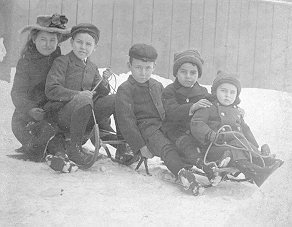
(Frances was 11 years old, I.A. 10, Rudolph 8, Eddie 7, and Murray 3)
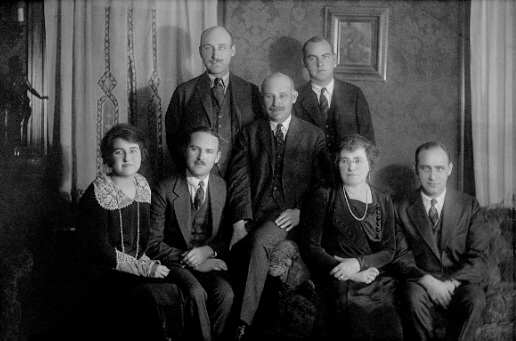
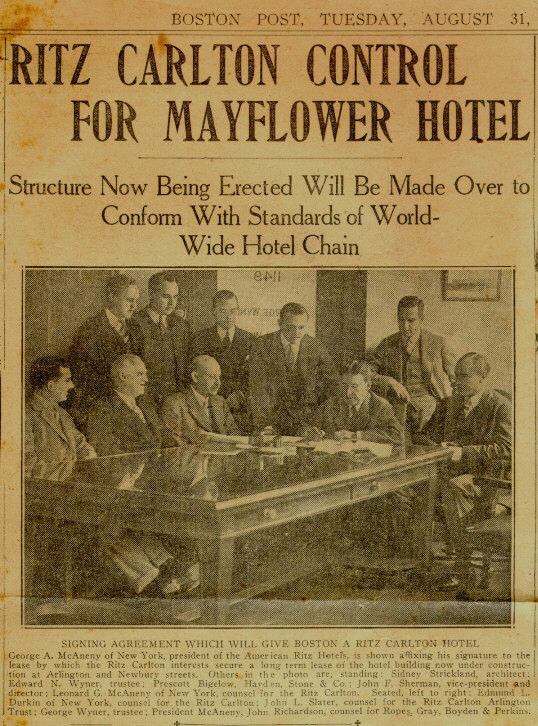
(George Wyner seated third from left, Edward Wyner standing behind him left)
Welcome
Welcome to the Wyner Family History website. This page was originally posted as part of the George Wyner Trust website. Our hope is to provide an information source for Family History, Business and Trust History, Geneaological Charts, Audio Clips, Home Movies, Photographs, and Current News on the locations, activities and history of family members, and Current Business News on the properties and current activities of the GEORGE WYNER TRUST, a Massachusetts trust which since 1943 has operated, and continues to operate, the real estate business founded by George Wyner in 1902.
Family Tree Charts
We will soon be posting a family tree of the descendants of George and Gussie Wyner. We are also working on a family tree beginning with the parents of George Wyner and his brother Henry (YEHUDA LEB WYNER and FAGEL REVA WYNER), and including all the children of George Wyner and Henry Wyner (an easy-to-view introduction to family history).
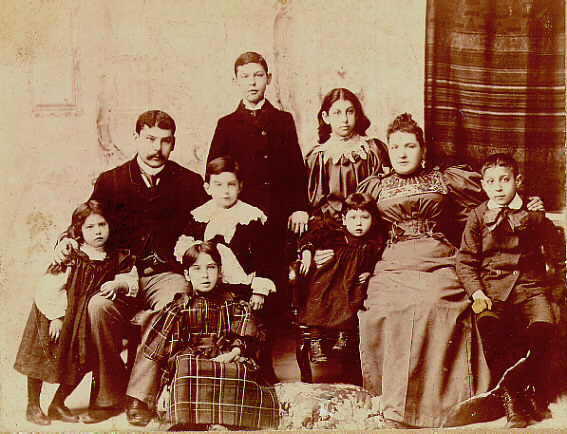
Also coming soon: a family tree of the descendants of Henry Wyner, George’s elder brother, and his wife, Annie Mickleshanski Potruch.
We are also going to post a copy of a 1903 family tree (prepared for the “Cousins Party” of 1903 given by Louis A. Freedman a cousin of Annie Wyner, not to be confused with Louis M. Fredman, another of Annie’s cousins, who married Annie and Henry’s daughter Rachel), showing the ancestors of Henry Wyner’s wife, Annie Mickelshanski Potruch (going back to 1762 and to the Abravanel family).
A Brief History of George and Gussie Wyner
(A Note as to Family History: Keep in mind that memories become inexact over time, and much of what is here is from a second- or third-hand re-telling by our parents and grandparents of the original events. Some of these stories were passed down in different versions by George and Gussie’s children, so don’t be surprised if any family history recounted here fails to match the stories you have heard. Please, send us your version of any episode you have heard differently, and we will try to incorporate all alternatives.)
1863-1898: Russia to South Africa
George Wyner was born on December 26, 1863, in Vilna, in the Lithuanian area of the Czarist Russian Empire, the youngest son of Yehuda Leb Wyner and Fagel Reva Wyner. (His given name was Gershon Eleazar, which he later anglicized upon arrival in London as George, for Gershon, and Wyner, as an English spelling of the Yiddish derivation from Vilna, spelled Wilno in Polish/Lithuanian).
Frances always recounted that George’s father had rented apple orchards. Supposedly, George’s first job was at age five, guarding the apple orchards against wild animals. It seems that George’s father was not poor, although poverty among friends and neighbors was a theme of George’s childhood. George didn’t complain, but he told one story about poverty. He used to tell about visiting relatives for dinner, and he remebered loving the cooked prunes that were served for dessert. He was always told by his parents never to eat the last one on his plate, no matter how much he liked them, because the hosts might then be humiliated, by feeling that their limited means had not allowed them to serve enough food.
George’s elder brother Henry was the first to leave Vilna, in about 1872, at the age of thirteen. Many Jewish families were anxious to have their children leave the country in that period. Jewish youths recruited into the Czarist army were pressured to abandon their religion, and a wave of anti-Semitism was encouraged by the authorities in the 1870s. The story passed down is that Henry became a cabin boy on a merchant ship, traveled far and wide, eventually to Australia, and from there to Singapore, where he started his first business. About 1877, he heard that economic opportunity was flourishing in South Africa. He boarded anther ship and landed in Cape Town, where he started a trading business with the Boer farmers. In about 1880, Henry was informed by his father that a marriage had been arranged for him in Vilna. Henry and George’s father, Yehuda Leb Wyner (Note: There are conflicting reports about George’s father’s name, and any recollections are appreciated) was a close friend of a wealthy Jewish man in the timber business, Solomon Mickleshanski, from the small town of Butrimonys, outside of Vilna. (It seems likely that Henry and George and their father lived in the same small town, and that Vilna, a well-know nearby city, not their home but simply the easiest way to describe their place or origin to strnager’s in later life.) The two older men had agreed that Henry should marry Solomon’s granddaughter, Annie Mickleshanski Potruch, then about twenty-two years old. Henry returned to Vilna, a long and dangerous journey, was quite taken with his arranged bride, and was married there. Frances used to tell the story that Henry had seen an unkwon youn woman in town the day of his arrival, and was impressed with her beauty, only to happily find that very evening that the unknown beauty was in fact his arranged bride. He soon brought Annie back to South Africa. Henry and Annie’s first child, Reuben, was born in Stellenbosch, near Cape Town, in 1882.
George left Vilna in about 1880, at the age of seventeen. He travelled first to London, and stayed with a relative living there. Rudolph in a 1949 letter indicated that George had stayed in London with Leon and Julia Eyges, Julia being Annie’s sister. Julia would probably at that time have become George’s sister-in-law (after Henry’s marriage to Annie). After a period of time, probaly no more than a few months, hearing the apparently glowing reports from Henry of business in South Africa, George joined Henry there and settled in Malmesbury, a small farming and wine-growing town in the countryside, a few miles from Stellenbosch and not far from Cape Town.
Much of George’s later-in-life storytelling (an entertaining source of humour and adventure for his children and gradnchildren) focussed on a friendly rivalry with Henry, who seems to have regarded George as a naive newcomer in the first stages of their joint business. Their early trading business consisted of buying tools, supplies and hardware in Cape Town, packing it on horses and mules, and riding into the countryside to sell to the mostly Boer (i.e. Dutch-desecnded Afrikaaner) farmers. Money was scarce in the beginning. Later on, George always told his family that he had to start out in business travelling on a horse with only one eye.
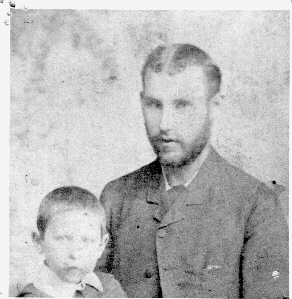
In a story reminiscent of the American West (and every family member has probably heard the details differently), George later told of a particularly memorable journey on horseback with Henry. They encountered a large troop of baboons, crowding around them on the sides of a trail. Henry was scared and wanted to turn back. With time and supplies limited, the nineteen-year old George insisted on forging straight ahead. The baboons appeared ever more menacing, at least to Henry, who finally spurred his horse to a gallop to get past the threat. At this point, George would, in his storytelling, recall that Henry was no great horseman, and Henry’s horse instantly became an out-of-control runaway. George, in the best Tom Mix cowboy fashion, chased after Henry, and while holding the reins of his own horse, pulled the frightened Henry onto his saddle, as Henry’s horse ran off into the distance. One assumes that George was sometime thereafter traded up from the one-eyed horse to better stock.
George soon acquired a reputation among the Boer farmers he met for absolute honesty and integrity, and perhaps a litle charm and wit as well. The business progressed when the Boer farmers started asking George and Henry to sell their grain for them in Cape Town. George and Henry set up a warehouse in Malmesbury to store grain for sale. The 1898 picture of George, family and employees, taken just before his departure, seems to be in front of that warehouse.
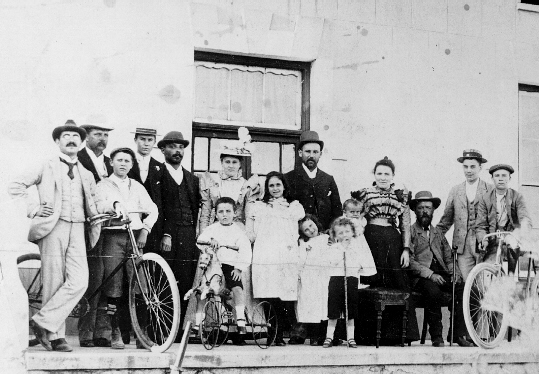
(From left: I.A., on bicycle sixth from left, unidentified woman and young girl, Frances, with head inclined left, George, Rudolph, Edward and Gussie)
By around 1891, at age twenty-eight, George had become sufficiently established that he felt ready to seek out a bride. Rudolph’s recollection was that George’s father had in 1891 agreed on a SECOND arranged marriage with his old friend, Solomon Mickleshanski, this time the idea being for George to marry Annie’s sister Masha, then living in Boston. George dutifully obeyed his fathwer’s requerst to travel to Boston, but landed fisrt in New York, for a suposedly short stay with a sister married to Judge Snitkin. Supposedly by accident, George noticed an attractive young girl named Gussie Edelmann, was quite taken with her, and cabled his father in Vilna for permission to change the marriage plans. His father told him to hold everything, and wait for the father to travel from Vilna to New York to look over the new intended. George and Gussie waited several anxious months, not knowing what would happen. Upon arrival, the father was impressed that Gussie’s father, Abraham Edelman, was a respected rabbi originally from Minsk (where Gussie was born), and gave his blessing to the unplanned marriage. (The unchosen Masha soon after married a Mr. Shearson in Boston, to no apparent harm).
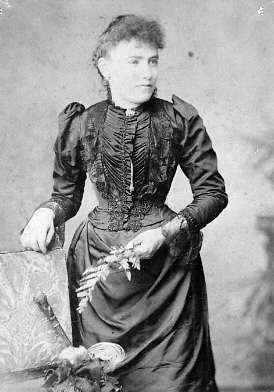
Goerge and Gussie were married in New York on August 18, 1891. George’s father found life in New York too hectic and returned to Russia almost immediately. George and Gussie soon left for South Africa, George supposedly promising that they would stay there just one year, allowing time for him to wind up his business affairs, and then return to New York to allow Gussie to be near her family. (She left behind in New York her parents, Abraham and Esther, and brothers Harry, Sam, Joseph, and Selig, as well as a sister Ida). Once in South Africa, however, the business apparently dragged out, and some remember Gussie saying that she grew to like the slower-paced lifelstyle in Malmesbury. The arrival of children then complicated the picure. George and Gussie’s first child, their daughter Frances, was born December 8, 1892, followed by Isadore Alfred (always known as “I.A.”) in 1894, Rudolph in 1895, and Edward in 1897. (Murray was born later, in America) George seems have to enjoyed business in South Africa (and to have been quite sucessful), with the exception of one story he used to tell about a crooked employee named something like Brodsky, to whom George entrusted a large sum of cash for deposit in the bank at Cape Town. When the employee failed to retun to work, George sensed something was amiss, and rushed on horseback to Cape Town. He went to the bank to find no money and then to the harbor, only to find the faithless Brodsky waving at him from the deck of a ship that had just depated for London. George tried to trace the thief in London without success. George seems to have been a man of character who was frequently uncomprehending of dishonesty in others.
The first “Boer” war broke out in 1898, as the British attempted to assert their authority over the independent-minded Boer (Dutch-Afrikaaner) farmers of the interior. Henry left in 1898, moving to Boston, where Annie had cousins already settled. George stayed on for perhaps a year, but the tension between the Boers in rural areas and the Britsh in Cape Town made his business difficult. He and Gussie decided to leave in 1899, stopping first in London for about three months(where the four-year-old Rudolph supposedly disappeared for a short time in the crowds at the World’s Fair), and from there on to New York, where Gussie’s family was still living. They arrived in New York in about August, 1899. Their fifth and last child, Murray, was after arrival in New York, on June 15, 1900. According to Frances, the two gentlemen at the far left of the 1898 picture were Boer business partners of George, to whom he turned over his remaining warehouse and trading business. She remembered George saying that the two gentlemen visited George in New York in 1902, having become extremely wealthy from the business left behind. George did not enjoy New York. He used to say later in life that he could never get used to the style of business in New York. He was accustomed to selling goods on credit in South Africa, with only a verbal promise to pay from the Boer farmers. He later said that he lost a “fortune” in his short stay in New York, from doing business with people who failed to stand by their word. George soon learned that America was a place that required written contracts. After a little less than two years, George decided in 1902 to move to Boston, where Henry and Annie had already settled. George and Gussie and the children moved into the house at 22 Gaston Street in Roxbury on the south side of Boston. It seems that George’s first business in Boston consisted of importing ostrich feathers. His first business stationery listed ostrich feathers under his name, and in 1903 he received a long letter from his brother-in-law Sam Edelman in Cape Town, written when Sam was working for him in business, describing Sam’s problems with locating ostrich feathers of good quality. At the same time, there is reason to think that he made real estate mortgage loans, and real estate financing was later substituted on his business stationery. (NOTE: Sam Edelman wrote another letter to Frances’ daughter Anne in 1929 from Johannesberg. If anyone knows where Sam Edelman ultimately settled, the information would be greatly appreciated.) George’s set up his offices at 18 Tremont Street, in the same building as Henry. They were soon joined by Henry’s son Reuben after his graduation from law school in 1904. Although George and Henry remained personally close, it seems that in Boston they ran their businesses mostly independently of each other. George may have had a greater enthusiasm for the buying and selling of tangible merchandise (or, as time went on, real estate). Perhaps their difference in temperament is revealed by the fact that three of Henry’s sons (Reuben, Sol, and Sammy) became lawyers, while all of George’s sons when into manufacturing businesses. In approximately 1910, George and Guissie and the children moved to the more spacious house at 61 Charlotte Street. George must have soon after acquired a camera, as the first “amateur” (i.e. non-studio) family photgraphs in taken in great number are apparently the ones dated 1912 (in handwriting on the negatives), and show Frances and the boys enjoying George’s new touring car, while horse-drawn cariages on the streets can still be seen in the backgound, and showing the whole family spending the summer at the beach (probably Cape Cod) withe George and Gussie’s close friends, the Lourie’s. [history unfinished]
My father, Henry Wyner is the daugher of Lillian Wyner and I think the nephew or Rudolph Wyner of Brookline. I have always heard of a South Africa connection.
Do you think this is the same Wyner family?